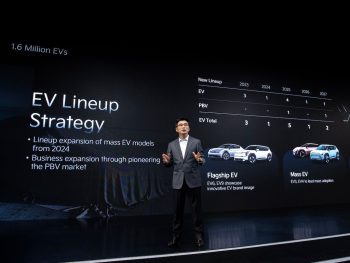Kia plans for more hybrids and EVs in evolving electrification roadmap
Kia will launch more hybrid cars alongside fully electric models under latest plans to “lead the global electrification” era.

Kia will launch six new EVs by the end of 2026 but its global line-up will now include more hybrid models
Its updated roadmap, revealed at the annual CEO Investor Day in Korea, will expand the EV line-up to 15 models in 2027, up from the previous figure of 14 and supporting existing plans for 1.6 million EV sales in 2030.
But the brand will also enhance its hybrid portfolio “to manage fluctuation in EV demand” as it warns of “uncertainties across the global mobility industry landscape”.
On the fully electric vehicle side, six EVs will arrive by 2026 – starting with the EV3 compact crossover revealed at last October’s EV Day and followed by the EV4 saloon and EV5 family SUV also showcased at the event. Kia also confirmed the arrival of the EV2 electric city car, due on sale by 2026. These new arrivals will launch in major markets, including the US, Europe and South Korea, while emerging markets will get two region-specific EVs, such as the Carens EV for the Indian market.
Kia also pledged a “competitive product and differentiated service” to help counter challenges from the rising Chinese brands for fully electric vehicles. Its multi-strand policy will strengthen its product competitiveness, establish a global service and parts operation system, and use Chinese factories for other emerging markets.
Kia’s upcoming modular PBVs (Platform Beyond Vehicle) will also play a key role in growth plans for EVs and to fight back against Chinese challengers. Showcased at January’s CES event with the PV5 and PV7 models and targeting electric van demand, its PBVs provide customised vehicles and solutions for both B2B and B2C sectors. The brand is targeting 250,000 PBV sales annually by 2030 with the PV5 and PV7.
Other plans for fully electric vehicle growth include upgraded battery technology, using nickel-cobalt-manganese (NCM) batteries with targeted +7% energy density to improve performance and drive cost competitiveness, potentially with a 10% cost reduction. The brand will also provide various battery options, including more affordable lithium iron phosphate (LFP) batteries, to meet the diverse needs of global markets. Kia is also pushing a charging infrastructure expansion strategy around the globe.
Hybrid electric vehicles (HEVs) also factor in heavily in the latest strategy on the back of increased demand – and the brand is now planning to boost its HEV line-up from six models in 2024 to nine models by 2028, with HEV powertrain options offered for most major models. These next-generation hybrid powertrains will offer improved performance, torque and fuel efficiency.
The Korean carmaker said adding more HEVs to its plans would help accelerate customer consideration and uptake of electrified models across all markets, enabling it to “respond agilely to changes in the market environment” and “secure maximum flexibility in its line-up operation”.
A spokesperson said: “While the long-term EV demand for 2030 is expected to remain unchanged, the pace of demand growth may prove uneven in the near term. Factors such as a weaker global economic growth, reduction of EV subsidies, and slower adaption of charging infrastructure might affect EV demand.”
Boosted by the arrival of the new HEVs, plug-in hybrid (PHEVs) and battery EVs, Kia plans to increase sales of electrified models to 2.48 million units, representing 58% of sales, in 2030, with 882,000 units of HEVs and PHEVs. That’s a three-percentage point increase from last year’s target and strengthens Kia’s strategy to change the sales structure with an even greater focus on electrified line-ups.
Product plans also include a push on greater connectivity, autonomous driving, performance and design. The brand will improve its connectivity technologies based on the latest 5G network, such as advanced over-the-air systems and fuel efficiency driving using artificial intelligence (AI). It will also focus heavily on the expansion of software-defined vehicles (SDVs) to deliver enhanced convenience and safety features, drawing on high-speed connectivity and the latest AI technologies.
Its highway driving assist (HDA) technology will be further developed amid plans to expand the system’s scope to autonomous driving in the cities by 2026 through the continuous development of high-resolution precision sensors and autonomous driving software.
Kia also plans to continue releasing top-rung GT trim variants of its EV models, including the EV9 GT, in January 2025. The Ev9 GT will have 0 to 62mph acceleration of 4.0 seconds from a high-power dual-motor powertrain, along with uprated suspension and brakes.
Ho Sung Song, Kia president and CEO, said: “Following our successful brand relaunch in 2021, Kia is enhancing its global business strategy to further the establishment of an innovative EV line-up and accelerate the company’s transition to a sustainable mobility solutions provider. By responding effectively to changes in the mobility market and efficiently implementing mid- to long-term strategies, Kia is strengthening its brand commitment to the wellbeing of customers, communities, the global society and the environment.”

